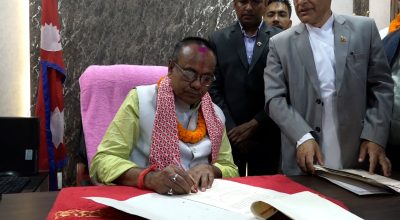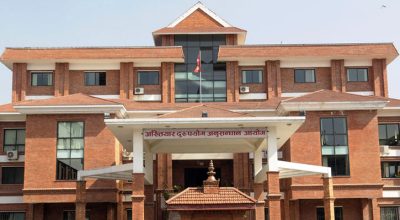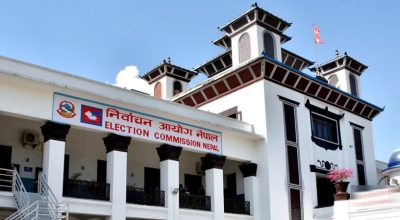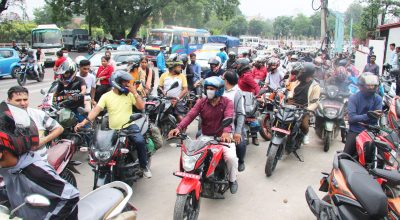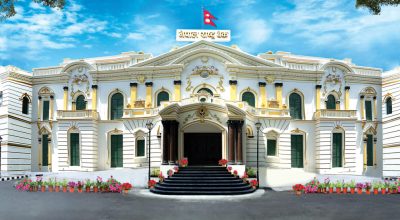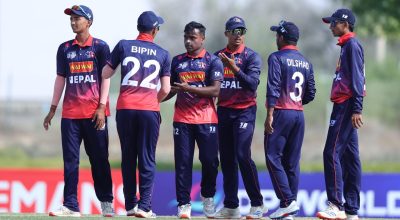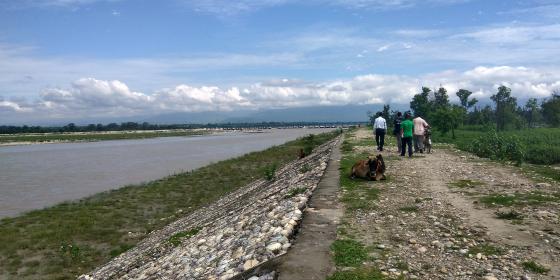
Kathmandu, Aug 28: Padam Kumari Magar is enthusiastically working to put boulders inside a metal gabion wire, on the banks of Bhatahi river in Sindhuli. At the moment the ‘river’ is a dry bed of stones, boulders, and sand, and about two dozen people are actively working to put an embankment on its side.
“Every year, this river floods in the monsoon and enters nearby areas. My fields lie to one side of it, and my sister’s fields lie to the other side. They are routinely destroyed by floods. We are grateful that you gave us the materials and the labor cost to put up this embankment. We have received employment, and our fields are now safe from floods,” says Magar, smiling in hope.
Magar is a farmer, and farming is the main source of livelihood for her family of five – she and her husband, two sons and a daughter. Currently, rows and rows of corn are growing on her field in one side of the riverbank, and she also plants rice and lentils in season. Every year, she and her extended family are scared that the monsoon rains will wash away their produce and leave them nothing to eat.
“Last year, a flood had entered my sister’s fields and destroyed it. My nephew had worked hard to protect the fields with an embankment, but it was of no use. So now, we hope that this embankment built with the help of BRCRN will help us make a living from our farm,” she says.
Constructing riverbank stabilization structures is a part of BRCRN ‘s work, done to improve the climate resilience of the people who live in eastern Chure region. Till date, BRCRN has constructed 96 such embankments across Koshi, Madhesh, and Bagmati provinces, benefiting more than 40 thousand people.
These embankments are often built on the sides of seasonal streams, called ‘khahare’ in Nepali. The streams are mostly dry in autumn and winter, with the riverbeds full of rocks, silt and sand. In monsoon, with the sudden onset of rains, the rivers often flood. Unlike snow-fed rivers that flow all the year round and have a more predictable path and volume, these seasonal streams are entirely unpredictable, their paths and volumes differing every year. And in monsoon, they often stray from their path and destroy nearby homes, settlements, structures, and farms.
The Sisne Khahare Khola in Sindhuli is an example. At Sisne, the river flows through a settlement of indigenous Tamang people, who live in mud homes with thatched roofs. In the past, the river had displaced several households, some of whom shifted to the end of the village, and some left the settlement entirely to migrate to Terai. This year, BRCRN helped put an embankment on the side of the river, shielding the settlement of about 30 homes from seasonal floods. Resident Prem Bahadur Thokar hopes they won’t have to migrate in future.
“In the past, when the river flooded, we don’t sleep at night. We just patrolled the banks all night, keeping watch with torchlights on,” says Thokar. “But with this embankment, we are relieved. We hope to sleep soundly this year.”
BRCRN often works with the most vulnerable communities to protect them from the adverse impacts of climate change including flooding. One of them is Dilmaya Waiba, who lives on the banks of the Sisne Khahare river in Sindhuli. She makes a living by farming her meager land, working for wage on other farms, and raising goats. From these activities, she provides livelihood for her son and daughter, while also supporting her disabled sister who lives with her. Every year, during monsoon, she is afraid that the river will break its bank and flood her home.
“This year, we have built this embankment by raising funds from several sources. BRCRN helped us build a stretch of this embankment, which will surely protect our homes form being destroyed,” she says, adding with a touch of pride that she and other women also worked on the embankment herself. “Women made this wall. Women and men together contributed to it, isn’t it beautiful?” she asks.





